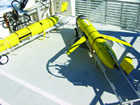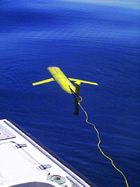MONITORING:
-
FWRI and Mote do transects from Sarasota to Naples testing for red tide
-
Volunteer Fishing Captain program send water samples to FWRI
-
Breve Buster - Mote developed this technology to automatically monitor
for red tide in Charlotte Harbor 24/7



MITIGATION:
- Health - Mote and FL DOH are developing new tools to mitigate
red tide affects on people

- Clay- Woods Hole Oceanographic Institute and Mote are doing research on the use of clay to mitigate red tide blooms which is used in the far east and are testing to better understand the environmental affects of using it as
A mitigation technique.
- Ozone research
- Natural substance
- May kill red tide
- Testing to insure environmentally safe
- Mote Marine Laboratory is doing the project
|
|
|
|
|
Research and Remediation |
Leading scientific reports on research and remediation being done in the areas of our most immediate concern are listed below:
|
|
|
|
|
Selected publications concerning the Gulf Of Mexico's growing 'Dead Zone' |
Oxygen depletion in the Gulf of Mexico adjacent to the Mississippi River.
by Dr. Nancy Rabalais, and R. E. Turner. 2005
Modeling the impacts of decadal changes in riverine nutrient fluxes on coastal eutrophication near the Mississippi River Delta.
by D. Justic, Dr. Nancy Rabalais and R. E. Turner. 2002
|
|
Selected publications outlining recent work done by ECOHAB participants |
Harmful Algal Blooms in Florida
by K.Steidinger, J.Landsberg, C.Tomas, and J.Burns
submitted by the HAB Task Force Technical Advisory Group March 8, 1999 Overview of major HABs affecting Florida waters. Includes K.brevis, Pfiesteria-like species, Ciguatera and Cyanobacteria.
The Economics of Harmful Algal Blooms (HABs): An Annotated Bibliography
by A.Tomerlin and C.Adams
Florida Sea Grant Program, Technical Paper 98, June 1999 Covers HABs nationwide and some abroad.
|
|
|
|
|
Recommendations for further work |
Harmful Algal Blooms in Florida
Priority Research Recommendations 1999/2000
Prepared by the Florida Harmful Algal Bloom Task Force October 1, 1999
For red tide it recommends:
- Predict the onset and movement of red tides in shelf waters.
- Develop epidemiological studies to determine red tide related health risks.
- Determine the fate and effect of toxins in the marine environment, including water, sediment, air, and food webs.
- Develop economic impact studies to properly evaluate losses due to red tide by coastal communities and industry.
- Investigate existing technologies for effective dead fish cleanup.
- Investigate the applicability and efficacy of control and mitigation methods for red tide.
- Continue and enhance public information and outreach programs.
|
|
|
|
|
Results from a recent symposium on red tide |
ECOHAB: FLORIDA ECOLOGY AND OCEANOGRAPHY OF HARMFUL ALGAL BLOOMS (Symposium abstracts)
Recent work among ECOHAB researchers was presented at a symposium on harmful algal blooms held at Woods Hole, MA on December 5-9, 2000. Abstracts of the presentations and posters are available on the internet at http://www.floridamarine.org Click red tide and select the symposium. All the abstracts concern Karenia brevis. Titles , and in some instances, a few words about content , are given below. We urge the reader to go to the web site given above and look over the original abstracts.
|
|
|
|
|
ECOHAB:FLORIDA OVERVIEW-THE ENVIRONMENT
ROLES ENDOGENOUS CELLULAR RHYTHMS AND LIFE CYCLE STAGE RECRUITMENT IN G. BREVE BLOOM DEVELOPMENT
ECOHAB FLORIDA: FATE AND EFFECTS OF BREVETOXINS IN SELECTED BIOTA , WATER, AND SEDIMENTS ALONG THE WEST FLORIDA SHELF,USA
ECOHAB-FLORIDA : BIO-OPTICS AND PHYSIOLOGY
Discusses the effects of natural irradiance and high irradiance acclimation in the laboratory.
FLORIDA HYDROGRAPHY AND NUTRIENT CHARACTERISTICS WITHIN THE ECOHAB: FLORIDA CONTROL VOLUME ON THE WEST SHELF
ECOHAB: FLORIDA, PHYSICAL OCEANOGRAPHY
COUPLED NUMERICAL MODELS OF FLORIDA RED TIDES OF Karenia brevis.
IDENTIFICATION OF CEL CYCLE REGULATORS IN THE FLORIDA RED TIDE DINOFLAGELLATE, Karenia brevis
PHOTOPHYSIOLOGICAL RESPONSES OF THE RED- TIDE DINOFLAGELLATE Karenia brevis (DINOPHYCEAE) UNDER NATURAL SUNLIGHT
THE RELATIONSHIP BETWEEN THE OCCUPATRIONAL EXPOSURE TO Karenia brevis (DINOPHYCEAE) TOXIN AND PULMONARY FUNCTION
SEARCHING FOR VIRUSES INFECTIVE FOR Karenia brevis
INTRA-CELLULAR, PARTICULATE AND DISSOLVED BREVETOXIN DISTRIBUTION DURING Karenia brevis BLOOMS IN THE GULF OF MEXICO, USA
ESTABLISHING AND MAINTAINING CLONAL CULTURES OF Karenia brevis
DEVELOPMENT OF THE VOLUNTEERS OFFSHORE RED TIDE MONITORING PROGRAM FOR THE GULF COAST OF FLORIDA
OBSERVATIONS OF CURRENT RED TIDES (Karenia brevis BLOOMS)
|
|
|
|
|
|
|
FLOCCULATION WITH CLAY
Clay particles spread over water containing K.brevis will attach to them and settle to the bottom. A ship, a source of clay, a procedure, and funds are ready to go when red tide incidents occur.
REMOVING DEAD FISH FROM WATER BEFORE THEY CAN WASH UP ASHORE
Using a vessel designed for collecting spilt oil, fish are chopped up and returned to the sea. More tests must be run to assure the state of Florida that this technique will not adversely affect water quality. A field study has been designed, vessel selected, program funded and process implemented during red tide incidents. |
|
|
|
|
|
| |